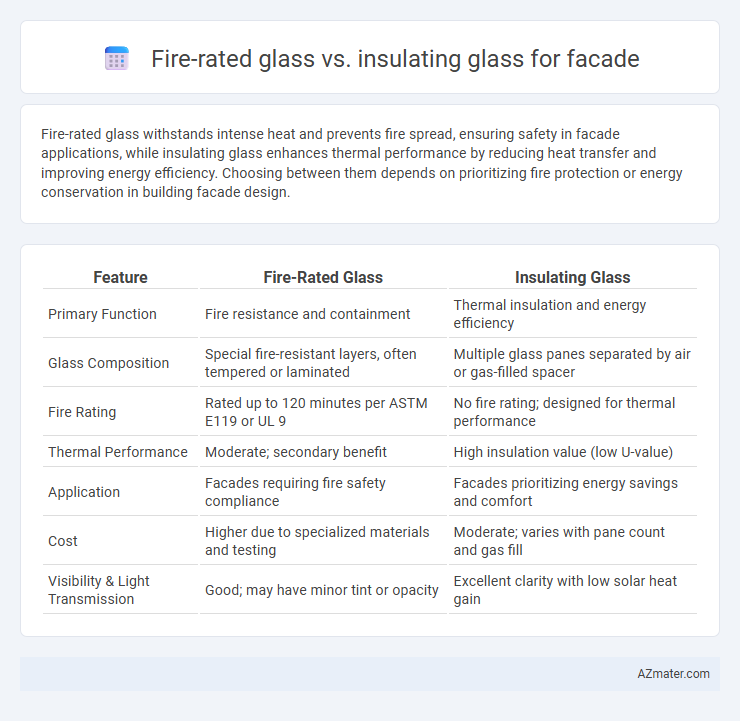Fire-rated glass withstands intense heat and prevents fire spread, ensuring safety in facade applications, while insulating glass enhances thermal performance by reducing heat transfer and improving energy efficiency. Choosing between them depends on prioritizing fire protection or energy conservation in building facade design.
Table of Comparison
| Feature | Fire-Rated Glass | Insulating Glass |
|---|---|---|
| Primary Function | Fire resistance and containment | Thermal insulation and energy efficiency |
| Glass Composition | Special fire-resistant layers, often tempered or laminated | Multiple glass panes separated by air or gas-filled spacer |
| Fire Rating | Rated up to 120 minutes per ASTM E119 or UL 9 | No fire rating; designed for thermal performance |
| Thermal Performance | Moderate; secondary benefit | High insulation value (low U-value) |
| Application | Facades requiring fire safety compliance | Facades prioritizing energy savings and comfort |
| Cost | Higher due to specialized materials and testing | Moderate; varies with pane count and gas fill |
| Visibility & Light Transmission | Good; may have minor tint or opacity | Excellent clarity with low solar heat gain |
Introduction to Fire-Rated and Insulating Glass
Fire-rated glass is specially designed to withstand high temperatures and prevent the spread of flames and smoke in building facades, meeting strict fire safety codes. Insulating glass, also known as double or triple glazing, enhances thermal performance by reducing heat transfer and improving energy efficiency in exterior walls. Both glass types serve critical roles in facade construction, balancing fire protection and thermal insulation requirements.
Understanding Fire-Rated Glass: Key Features
Fire-rated glass provides essential fire resistance by withstanding high temperatures and preventing the spread of flames and smoke for a specified duration, typically ranging from 20 minutes to 2 hours. Its key features include high thermal stability, integrity under intense heat, and compliance with strict fire safety standards like UL 9 and BS 476. In comparison, insulating glass primarily improves thermal insulation and energy efficiency but does not offer the same level of fire protection required for facade applications in fire-rated assemblies.
Insulating Glass: Benefits and Applications
Insulating glass enhances thermal performance by reducing heat transfer and improving energy efficiency in building facades, making it ideal for climate control and reducing HVAC costs. Its multi-layered construction with gas fills and low-emissivity coatings provides sound insulation and minimizes condensation, contributing to occupant comfort. Commonly used in commercial and residential buildings, insulating glass supports sustainable design goals while maintaining clear views and natural daylight.
Performance Comparison: Fire Resistance vs. Thermal Insulation
Fire-rated glass for facades offers superior fire resistance by withstanding high temperatures and preventing flame and smoke penetration, making it essential for safety in building fire scenarios. Insulating glass prioritizes thermal insulation, significantly reducing heat transfer and improving energy efficiency through multiple panes and gas fills but lacks fire-resistant properties. Comparing performance reveals fire-rated glass excels in fire containment, while insulating glass delivers optimal thermal insulation, requiring careful selection based on building safety and energy goals.
Safety and Compliance Standards
Fire-rated glass provides critical fire resistance by withstanding high temperatures and preventing the spread of flames and smoke, meeting stringent safety standards like UL 9 and BS 476. Insulating glass enhances thermal performance and energy efficiency but lacks the fire protection required for compliance with fire safety codes. Selecting fire-rated glass for facades ensures adherence to building regulations and occupant safety in fire emergencies, while insulating glass primarily addresses thermal insulation needs.
Energy Efficiency Considerations
Fire-rated glass is designed primarily to prevent the spread of flames and heat during a fire, offering essential safety benefits for building facades but typically has lower insulation properties compared to insulating glass. Insulating glass units (IGUs), composed of multiple glass panes separated by air or gas-filled spaces, significantly enhance thermal performance by reducing heat transfer and improving energy efficiency in facades. Choosing between fire-rated glass and insulating glass depends on balancing fire safety requirements with energy efficiency goals, often necessitating integrated solutions that meet both standards.
Design Flexibility and Aesthetic Impacts
Fire-rated glass offers robust safety features while maintaining design flexibility through slim profiles and transparency options, ensuring compliant facades without compromising aesthetics. Insulating glass enhances energy efficiency with multi-pane configurations and low-emissivity coatings, enabling sleek, modern facades that optimize natural light and thermal performance. Both glass types support innovative architectural designs, but fire-rated glass prioritizes safety integration whereas insulating glass excels in thermal insulation and visual comfort.
Cost Implications and Budget Planning
Fire-rated glass offers enhanced safety by providing resistance to high temperatures and flames, typically commanding higher upfront costs due to specialized materials and rigorous testing standards. Insulating glass focuses on energy efficiency with double or triple glazing, generally at a lower price point but may require additional fire protection measures if used in fire-rated assemblies. Budget planning must balance regulatory compliance and long-term energy savings, considering that fire-rated glass can reduce insurance premiums while insulating glass decreases operational energy expenses.
Choosing the Right Glass for Your Facade
Fire-rated glass provides crucial fire resistance and containment, essential for facades in buildings requiring strict safety regulations, while insulating glass excels in thermal performance and energy efficiency for climate control. Selecting the right glass depends on balancing fire safety standards with energy conservation needs, considering factors such as local building codes, facade orientation, and performance criteria. Prioritizing facade glass that meets specific fire-resistance ratings and U-values ensures optimal protection and comfort in both commercial and residential constructions.
Conclusion: Deciding Between Fire-Rated and Insulating Glass
Choosing between fire-rated glass and insulating glass for facades depends on prioritizing safety versus energy efficiency. Fire-rated glass offers critical fire resistance, maintaining structural integrity during emergencies, while insulating glass enhances thermal performance and reduces energy costs. The decision hinges on building code requirements, climate considerations, and specific safety needs of the structure.

Infographic: Fire-rated glass vs Insulating glass for Facade
 azmater.com
azmater.com